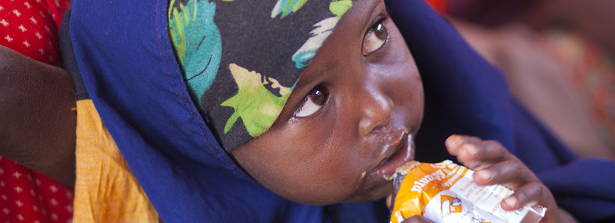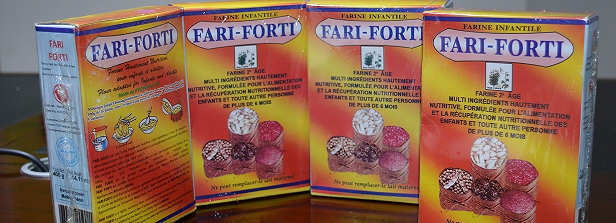Agroecological food resources for healthy infant nutrition in Benin (INFLOR)

Duration: October 2014 – October 2017. This project has been finalized.
Project information
Aim: To improve nutritional and safety requirements as well as access of communities to locally produced infant foods in Benin that are commercialized on national and regional markets.
Objective: To develop and promote a nutritionally improved, safe and affordable infant food based on local resources through i) comprehensive inventory and documentation of available local food ingredients per agro-ecological zone for the formulation of infant foods; ii) formulation of nutritionally-adequate infant foods from documented and available local resources; iii)assessing consumers’ perception and acceptability of the formulated and tested infant foods; iv)capacity building in producing the formulated products; and v) certification the quality of the optimized and tested products ; vi)dissemination of the project outputs.
Method: Consortium of private for profit company, research institution, and public organizations implementing a multidisciplinary approach, involving the knowledge and skills from the domain of consumers perception and behavior, marketing and economics, food formulation and processing, and human nutrition. The project will be implemented within seven work packages (WP) operating the specific objectives.
Country: Benin.
Dutch policy goal: Improved access to nutrition.
Progress reports
Year 2: INFLOR aims at developing and certifying new infant foods based on local food resources (LFR) and is being implemented through 7 work packages (WP). Activities planned for project year 2 involved WP2, WP3, WP4 and WP7.
WP2 aims to inventory and map the local food resources (LFR) available per agro-ecological zone for infant food formulation. Two tasks were implemented fully or partially this year namely processing of data related to local food resources (literature review, ethnobotanical survey and laboratory analyses, task 1) and manuscript writing (task 2).
Implementation of task 1 allowed the following outputs:
- One MSc thesis defended on local food resources for infant foods: diversity and nutritional value. This report identified a range of promising LFR for infant food formulation;
- Twelve nutritional maps realized on prominent LFR per agroecological zone;
- Two posters prepared: one deals with (i) iron, zinc and calcium bioavailability in LFRs traditionally used as ingredients for 4-24 months-old children complementary food production and one reports on (ii) diversity of LFRs traditionally used in infant feeding practices in Benin.
Within task 2, a draft critical review entitled Local food resources as ingredients for complementary food formulation: a review on availability and nutritional value in Benin was prepared. Besides, a manuscript is under preparation on the ethnobotanical survey data. From these data, itappearsthat138 resources from 123 species are used by local populations in the eight agroecological zones of Benin. Disparities exist in the distribution, diversity and use of LFR in agro-ecological zones for the infant food. Most exhibits very interesting nutritional value for infant flour production.
WP3 focused on the formulation of adequate infant foods based on documented and available LFRs. Three tasks were implemented during this year.
Task 1: Profiling LFRs for their toxins contents. Five LFR samples(maize, sorghum, soya, cowpea and groundnut) were collected from agro-ecological zones of Benin and screened for mycotoxins and pesticides residues. Pesticides and mycotoxins content of LFR were determined by HPLC at RIKILT Institute (The Netherlands). Pesticides residues were found in maize (Profenofos), sorghum (Chlorpyrifos), soya (Atrazine, Chlorpyrifos), and cowpea (Lambda-Cyhalothrin). Asmycotoxins, OchratoxineA (OTA) was detected in cowpea. A poster and a scientific paper are drafted.
Task 2: Design of (micro) nutrients dense flour and elaboration of recipes. MSc thesis conducted on this topic was completed and defended. Nine (9) formulations were primarily developed: one (01) intended for industrial exploitation and eight (08) for agro-ecological zones and flowcharts render available. They were assessed for proximate composition, pH and acidity, micronutrients, vitamins, total polyphenols, heavy metal, pesticides, and mycotoxins contents as well as microbial load (yeast and mould, total and faecal coliform). Analyses were performed at DNSA/FSA/UAC laboratories and Wageningen University and Research. Consumer preferences for these formulations were documented per agro-ecological zone.These formulations were in agreement with the Codex alimentarius in terms of energy; proteins and fat contents. Their micronutrients contents (Fe, Zn, P, Ca) were relatively high compared to complementary food flours available on Benin market. However, aflatoxine B1, diphenylamine and lindane were detected in some formulated flours mainly because of ingredients origins and hazard in process operations (malting process). Recommendations were formulated to avoid toxin and pesticide residues in the products. A scientific paper and a poster are in preparation.
Task 3: Storage behaviour of recipes. Msc research is ongoing on the behavior of the formulated flours during storage. Physico-chemicalproperties (pH, Acidity,acid value, peroxide value, proteins, lipids and minerals) of flours have been assessed for two months now.
WP4 aims at providing information on i)consumer perception on existing infant flours based on LFRs and ii) effect of the developed formulas on children growth and nutritional status. The food ethnography survey performed in 2014-2015 reported 313 local infant flours (LIF) listed on 61 places either drugstores (77%)or supermarkets (22%), in urban and semi-urban areas. Interviewed consumers (20 – 57%) had good attitudes towards the LIF. Indeed, 55% of interviewees perceived LIF as adapted to both urban and rural areas, 81% think that LFRs are available to be used for infants foods; and 15- 17% think that infant flours based on LFRs should comply with the standards regarding technological properties, nutrition and sanitary qualities, while being sensory acceptable by the children. Analysis are undergoing to determine the daily nutrient intake from the LIF among children. The MSc thesis will be defend in December 2016. A poster and a scientific paper are under preparation. Currently the proposal for the growth and tolerance study is under preparation.
Year 3: To develop new infant foods based on local food resources in Benin, this project first mapped the local food resources available per agro-ecological zone for the formulation of infant foods. Through a literature review the research team documented local food resources and their nutritional value, ranking them for their nutritional value. The top ten most relevant for instant flour were preselected for further investigations. Images of 34 nutritious local food resources were printed. Twelve assistants and a Msc student used these images in focus group discussions and interviews with key informants to collect data on what type of food is used for child nutrition, when these foods are available and how these are processed and stored. Also, perceptions on nutritional diseases, food believes and tabous were studied. Among the 34 local foods, 29 were recognized as food ingredients for children. 154 other local resources were mentioned as used for infant food. Laboratory tests are being done on 45 foods.
Formulation
Next, the team worked on formulations of adequate infant foods, using the local food resources identified in the research. The RIKILT institute in Wageningen analysed local food resources for their toxins contents. A master student designed a protocol to formulate new infant food, following criteria on nutrition, preference, availability and accessibility. In the following steps, one or more formulations will be made available per agroe-cological zone.
Consumers
Lastly, a food ethnography survey was realized to determine the availability and uses of the locally formulated infant foods by consumers. Also, the perceptions of consumers about using local food resources for producing infant flours were studied. One MSC student and 15 research assistants collected data, analysis is currently underway.
Final report
Summary of the results: The INFLOR project aims at developing and certifying new infant foods based on local food resources (LFRs). It involved Beninese (UAC/FSA) and Dutch (WU/FQD) researchers and quality insurers (ABSSA) under the leadership of a private food company (GPO). A diversity of LFRs (138 resources) is used in the eight agro-ecological zones of Benin for infant food production. Disparities exist in the distribution, diversity, use and nutritional value of LFR in agro-ecological zones for the infant food. Researchers formulated, closely with GPO, three infant foods for commercial and household use in rural areas, in agreement with the Codex Alimentarius and based on documented and available LFRs. With a shelf-life of six months, these formulas were accepted by consumers. Benin infant food market appeared to be highly competitive but still accessible to the commercial formula. The latter showed (i) at least 75% sensory acceptance rate among children and (ii) 95% nutritional rehabilitation of children with moderately acute malnutrition after 12 days of treatment. GPO was capacitated for producing the commercial formula, trademarked FARIFORTI. Raw material supply schemes were developed and production profitability index assessed as equal to 12.3 %. ABSSA allowed FARIFORTI consumption and commercialization (certificate no.ABSSA-AMM N°2823-001/18 of 13/03/18).


